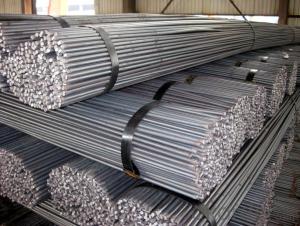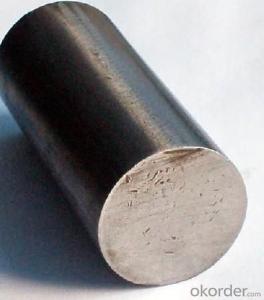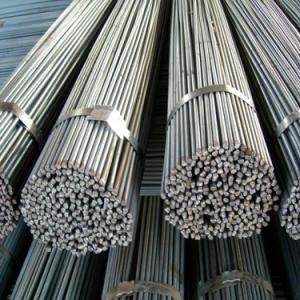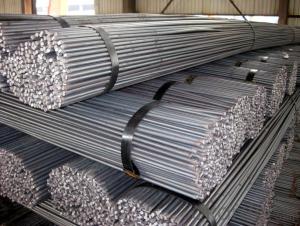GB 45#/SAE 1045 Steel Round Bar 20mm/25mm
- Loading Port:
- China main port
- Payment Terms:
- TT or LC
- Min Order Qty:
- 50 m.t
- Supply Capability:
- 10000 m.t/month
OKorder Service Pledge
OKorder Financial Service
You Might Also Like
GB 45#/SAE 1045 Steel Round Bar 20mm/25mm
Description:
-Specification: 20mm/25mm
-Length: 6m/12m
-Standard: GB/SAE/Japanese Standard
-Material: GB 45#/SAE1045/S45C
Chemical Composition of GB 45#/SAE 1045 Steel Round Bar 20mm/25mm:
| C | Si | Mn | P | S | Ni | Cr | Cu |
| 0.42-0.50 | 0.17-0.37 | 0.50-0.80 | ≤0.035 | ≤0.035 | ≤0.30 | ≤0.25 | ≤0.25 |
Packaging & Delivery of GB 45#/SAE 1045 Steel Round Bar 20mm/25mm:
Packaging Detail: All goods are packed in bundle with steel strips and shipped by break bulk vessel or container (depend on target market and different ports)
Delivery Detail: 45 days
MOQ: 50 tons per specification; we can negotiate the quantity if the specification is normal or we have stock of one specification.
Weight: The price invoicing on theoretical weight basis or actual weight basis depends on customer’s request.
Shipment: The shipment of bulk break or container is depends on customer’s request and the situation of the port of destination.
Documents given: Full set of original clean on board bill of lading; Original signed commercial invoice; Original packing list; Policy of insurance; Certificate of origin and what the target market needs.
Payment:
-Invoicing on theoretical weight or actual weight as customer's request.
-FOB, CFR or CIF.
-Regular terms of payment:
1, 30% payment in advance, the remaining balance (70% payment) against the copy of B/L.
2, 30% payment in advance, the remaining balance (70% L/C) against the copy of B/L.
3, Negotiable.
Images of GB 45#/SAE 1045 Steel Round Bar 20mm/25mm:
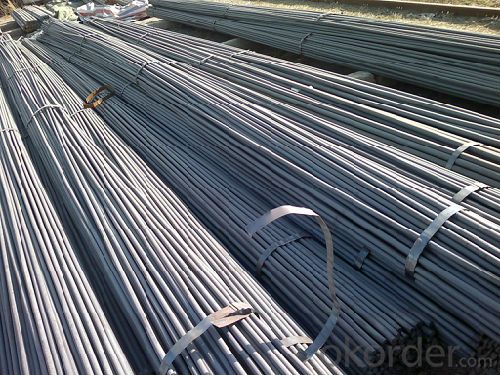
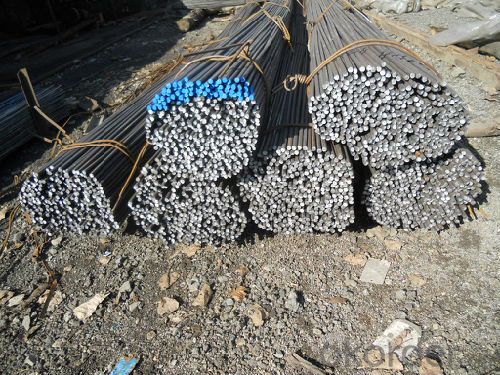
*If you would like to get our price, please inform us the size, standard/material and quantity. Thank you very much for your attention.
- Q:How are steel round bars used in the oil and gas industry?
- The oil and gas industry extensively utilizes steel round bars for a multitude of purposes. Primarily, these bars are crucial in drilling operations as they are employed in the production of drill bits and drill collars, which are essential components of drilling equipment. Given the substantial levels of stress and wear experienced during drilling, steel round bars provide the necessary strength and durability to withstand such conditions. Moreover, steel round bars are utilized in the construction of oil and gas pipelines. These pipelines are responsible for the long-distance transportation of crude oil, natural gas, and other petroleum products. By utilizing steel round bars in the manufacturing of these pipes, their strength and resistance to corrosion are guaranteed, enabling them to endure the harsh operating conditions. Additionally, steel round bars find application in the construction of oil and gas storage tanks and pressure vessels. These containers are employed for the storage and transportation of petroleum products and gases under high pressure. Steel round bars ensure the required structural integrity and strength, thereby ensuring the safe storage and transportation of these substances. Furthermore, steel round bars are involved in the fabrication of various other equipment that is utilized in the oil and gas industry, including valves, fittings, pumps, and compressors. These components are pivotal for the efficient and safe operation of oil and gas production facilities. To summarize, steel round bars play a vital role in the oil and gas industry by being used in drilling operations, pipeline construction, storage tank fabrication, and the manufacturing of various equipment. Their exceptional strength, durability, and resistance to corrosion make them an ideal choice for these demanding applications, ultimately guaranteeing the efficient and safe extraction, transportation, and storage of oil and gas.
- Q:What are the different grades of alloy steel round bars for automotive applications?
- There are several different grades of alloy steel round bars used for automotive applications, including 4140, 4340, and 8620. These grades offer varying levels of strength, toughness, and wear resistance, allowing them to be used in different automotive components such as shafts, gears, and axles. The choice of grade depends on the specific requirements of the application, taking into consideration factors like load capacity, durability, and cost.
- Q:What is the difference between a seamless and a turned steel round bar?
- A seamless steel round bar is produced by piercing a solid billet to create a hollow tube, which is then elongated and rolled to the desired size. This manufacturing method ensures a smooth and continuous surface, without any seams or welds. On the other hand, a turned steel round bar is a solid bar that undergoes machining operations to achieve the desired shape and dimensions. It is typically produced from a larger steel bar by removing material through turning or machining processes. Therefore, the main difference lies in the manufacturing process, with seamless round bars being hollow and formed through extrusion, while turned round bars are solid and shaped through machining operations.
- Q:What are the different grades of tool steel round bars?
- Various grades of tool steel round bars are offered, each possessing unique properties and characteristics tailored to specific applications. Examples of these grades include: 1. W1: With its relatively low carbon content, W1 is a water-hardening tool steel renowned for its exceptional toughness and good wear resistance. It finds common usage in cutting tools and woodworking tools. 2. O1: O1 tool steel round bars are oil-hardening tool steel boasting high carbon content. They exhibit excellent wear resistance, high toughness, and exceptional dimensional stability. O1 tool steel is frequently employed for punches, dies, and cutting tools. 3. A2: A2 tool steel round bars are air-hardening tool steel with moderate carbon and chromium content. They offer good wear resistance, superior toughness, and high dimensional stability. A2 tool steel is a popular choice for blanking and forming dies, as well as shear blades. 4. D2: D2 tool steel round bars are characterized by their high carbon and chromium content, providing outstanding wear resistance and good toughness. They exhibit remarkable resistance to abrasive wear and are commonly utilized in the production of cutting tools, punches, and forming dies. 5. M2: High-speed M2 tool steel round bars are enriched with a notable amount of tungsten, molybdenum, and vanadium. They deliver exceptional wear resistance, high red hardness, and good toughness. M2 tool steel is typically employed for high-speed cutting tools, drill bits, and machining tools. 6. S7: S7 tool steel round bars are air-hardening shock-resistant tool steel. They possess high impact toughness, good wear resistance, and excellent heat resistance. S7 tool steel is frequently applied in applications necessitating high shock resistance, such as chisels and hammers. These are merely a few instances of the diverse grades of tool steel round bars available in the market. The choice of grade hinges on factors such as the specific application, desired hardness, wear resistance, toughness, and heat resistance required. It is crucial to seek guidance from a knowledgeable supplier or metallurgist to ascertain the most appropriate grade for a given application.
- Q:What are the different types of steel round bar surface finishes used in the construction industry?
- The different types of steel round bar surface finishes commonly used in the construction industry include mill finish, hot rolled, cold drawn, and polished finishes.
- Q:How are steel round bars used in the manufacturing of agricultural implements?
- Due to their durability, strength, and versatility, steel round bars are widely used in the manufacturing of agricultural implements. Typically made of carbon steel, these bars offer excellent resistance to wear and tear, making them ideal for heavy-duty applications in the agricultural industry. Plows, an essential tool for breaking up and turning over soil, heavily rely on steel round bars. These bars are used to construct the plow's main framework, ensuring it can withstand the high levels of force and pressure exerted during tilling. Similarly, harrows, which cultivate the soil after plowing, also benefit from the use of steel round bars. These bars provide the necessary strength to withstand rigorous use without bending or breaking, guaranteeing their longevity and effectiveness. Apart from plows and harrows, steel round bars find common usage in the fabrication of other agricultural implements like cultivators, seeders, and sprayers. These implements require sturdy and durable components to endure the demanding conditions of agricultural operations. Steel round bars provide the strength and structural integrity needed for these implements to perform their intended functions effectively. Furthermore, livestock equipment such as gates, fences, and cattle panels also rely on steel round bars. These components must be strong and robust to contain livestock and withstand their movements and force. Steel round bars fulfill these requirements, ensuring the safety and security of animals and the durability of the equipment. In conclusion, steel round bars play a crucial role in the manufacturing of agricultural implements. Their durability, strength, and versatility make them an ideal choice for creating sturdy and reliable equipment that can withstand the demanding conditions of the agricultural industry.
- Q:What are the different grades of alloy steel round bars for automotive applications?
- There are several different grades of alloy steel round bars used for automotive applications, including 4140, 4340, and 8620. These grades offer varying levels of strength, toughness, and wear resistance, allowing them to be used in different automotive components such as shafts, gears, and axles. The choice of grade depends on the specific requirements of the application, taking into consideration factors like load capacity, durability, and cost.
- Q:What are the advantages of using nickel-chromium-molybdenum alloy steel round bars?
- There are several advantages of using nickel-chromium-molybdenum alloy steel round bars: 1. High strength and durability: Nickel-chromium-molybdenum alloy steel round bars have excellent mechanical properties, including high tensile strength and hardness. This makes them ideal for applications that require a strong and durable material. 2. Corrosion resistance: The addition of nickel and chromium in the alloy steel composition enhances its resistance to corrosion, making it suitable for use in environments where exposure to harsh chemicals or moisture is a concern. This corrosion resistance extends the lifespan of the round bars and reduces the need for frequent replacements. 3. Heat resistance: Nickel-chromium-molybdenum alloy steel round bars can withstand high temperatures without losing their structural integrity. This makes them suitable for applications that involve exposure to extreme heat, such as in the manufacturing of boilers, heat exchangers, and other heat-resistant equipment. 4. Versatility: The nickel-chromium-molybdenum alloy steel round bars can be easily machined and fabricated, allowing for various shapes and sizes to be produced. This versatility makes them suitable for a wide range of applications in industries such as aerospace, automotive, oil and gas, and construction. 5. Fatigue resistance: The alloy composition of nickel-chromium-molybdenum steel enhances its fatigue resistance, making it suitable for applications subjected to cyclic loading or repeated stress. This property ensures that the round bars can withstand prolonged use without experiencing fatigue failure. 6. Weldability: Nickel-chromium-molybdenum alloy steel round bars have good weldability, allowing for easy joining or fabrication processes. This makes them suitable for applications that require welding or other forms of joining, providing flexibility in design and construction. Overall, the advantages of using nickel-chromium-molybdenum alloy steel round bars make them a preferred choice in various industries where strength, durability, corrosion resistance, heat resistance, versatility, fatigue resistance, and weldability are crucial factors for success.
- Q:What is the difference between a turned and a polished steel round bar?
- The surface finishes and properties of a turned steel round bar and a polished steel round bar are different as a result of separate processes they undergo. Typically, a turned steel round bar is created by removing material from the surface of a steel bar using a lathe machine. This process involves rotating the bar against a cutting tool, which cuts away the outer layer, leaving a smooth and cylindrical surface. Although the turned bar may have visible machining marks, it is generally known for its precise and uniform diameter compared to other types of steel bars. Turned bars are commonly used in applications where dimensional accuracy is crucial, such as in machinery or tooling. On the other hand, a polished steel round bar goes through a different process involving grinding or buffing the surface to achieve a smooth and reflective finish. Polishing eliminates any imperfections or roughness, resulting in a highly lustrous appearance. Polished bars are often utilized in decorative applications or where visual aesthetics play a significant role, such as in architectural designs or high-end consumer products. To summarize, the main distinction between a turned and a polished steel round bar lies in their manufacturing processes and resulting surface finishes. A turned bar is machined to achieve precise dimensions, while a polished bar undergoes a polishing process to obtain a smooth and reflective surface. The choice between the two depends on the specific requirements of the application, with turned bars being preferred for dimensional accuracy and polished bars for aesthetic appeal.
- Q:What are the different joining methods for steel round bars?
- There are several different joining methods for steel round bars, including welding, brazing, and mechanical fastening. Welding involves melting the ends of the bars and fusing them together, creating a strong bond. Brazing is a similar process but uses a lower temperature filler metal to join the bars. Mechanical fastening methods, such as using bolts or screws, involve securing the bars together with external connectors. The choice of joining method depends on factors such as the application, desired strength, and ease of implementation.
1. Manufacturer Overview |
|
|---|---|
| Location | |
| Year Established | |
| Annual Output Value | |
| Main Markets | |
| Company Certifications | |
2. Manufacturer Certificates |
|
|---|---|
| a) Certification Name | |
| Range | |
| Reference | |
| Validity Period | |
3. Manufacturer Capability |
|
|---|---|
| a)Trade Capacity | |
| Nearest Port | |
| Export Percentage | |
| No.of Employees in Trade Department | |
| Language Spoken: | |
| b)Factory Information | |
| Factory Size: | |
| No. of Production Lines | |
| Contract Manufacturing | |
| Product Price Range | |
Send your message to us
GB 45#/SAE 1045 Steel Round Bar 20mm/25mm
- Loading Port:
- China main port
- Payment Terms:
- TT or LC
- Min Order Qty:
- 50 m.t
- Supply Capability:
- 10000 m.t/month
OKorder Service Pledge
OKorder Financial Service
Similar products
New products
Hot products
Related keywords
